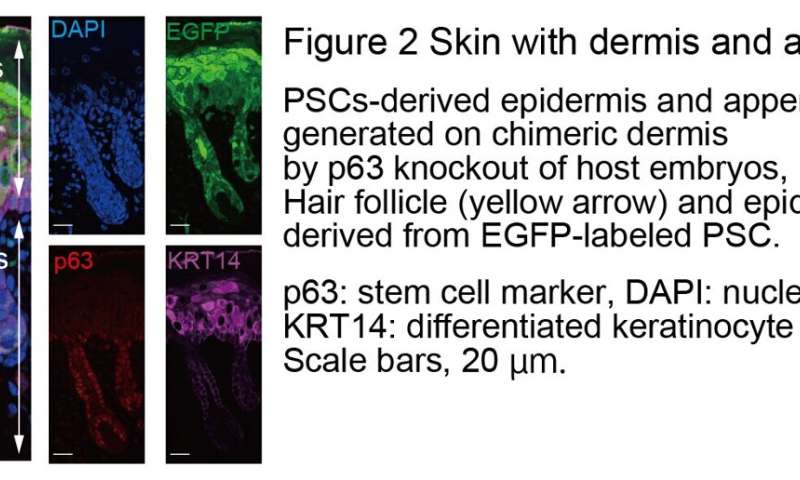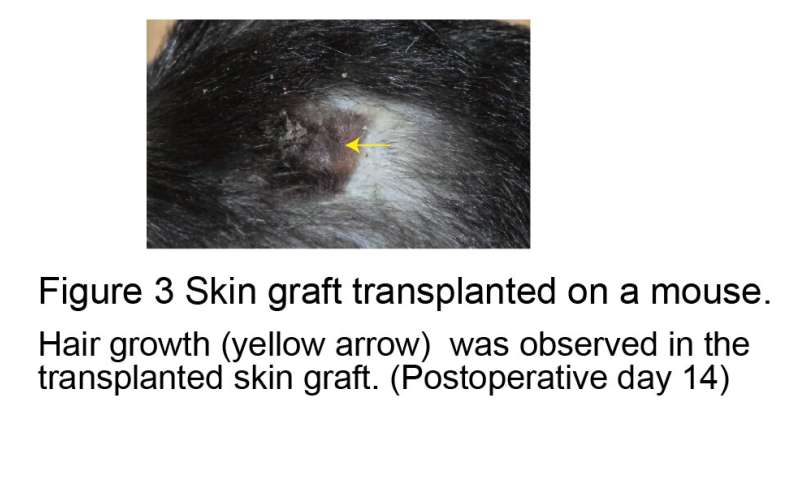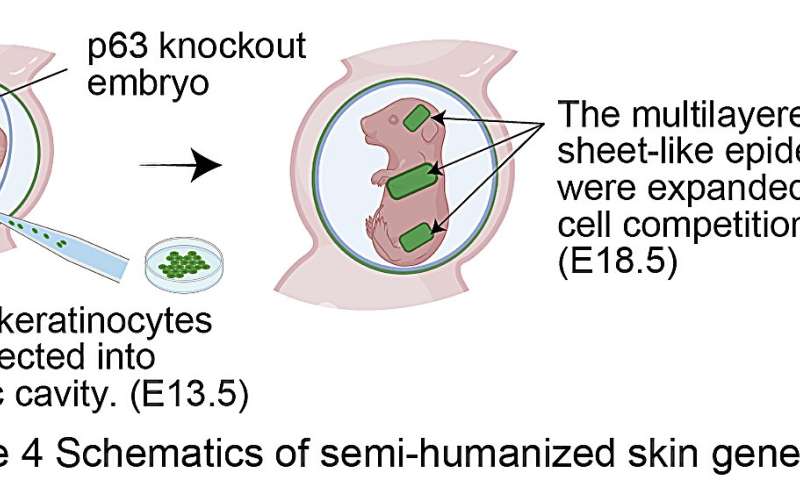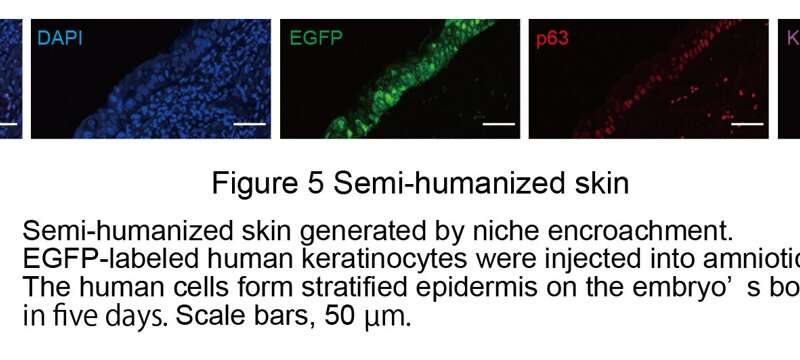This article has been reviewed according to Science X's editorial process and policies. Editors have highlighted the following attributes while ensuring the content's credibility:
fact-checked
peer-reviewed publication
trusted source
proofread
Grow the skin you're in: In vivo generation of chimeric skin grafts

Researchers from Tokyo Medical and Dental University (TMDU) have found that donor keratinocytes injected into mouse embryos form sheets of epidermis that can be used as autologous skin grafts.
Skin grafting is an essential procedure used to treat severe skin wounds. In the case of extensive wounds, however, it can be challenging to harvest enough donor skin, and generating artificial skin substitutes that include hair follicles and sweat glands and can engraft on deep wounds has not been successful. Now, researchers from Japan report a new way to "grow your own" donor skin that could help improve the success of skin graft generation.
In a study published in Nature Communications, researchers from TMDU have revealed that growing donor skin in another species yields surprisingly robust and functional skin grafts.
The gold standard for treating burn wounds is autologous skin grafting, a process in which sheets of skin containing both the epidermis (the outer layer) and the dermis (the deeper layer) are transferred from other parts of the patient's body to cover the wounded area.
However, for large wounds it can be difficult to harvest enough skin from the limited donor sites. Split-thickness grafts that contain mostly epidermis with only some dermis can be used to cover larger areas, but they do not include features like hair and sweat glands, and are more prone to shrinkage and scarring.
-

PSCs-derived epidermis and appendages generated on chimeric dermis by p63 knockout of host embryos, Hair follicle (yellow arrow) and epidermis were derived from EGFP-labeled PSC. Credit: Stem Cell Therapy Laboratory, TMDU -

Hair growth (yellow arrow) was observed in the transplanted skin graft. (Postoperative day 14). Credit: Stem Cell Therapy Laboratory, TMDU
"As alternatives to autologous skin grafts, artificial skin substitutes including cultured epidermis and reconstituted skins have been developed," says the lead author of the study, Dr. Hisato Nagano. "These options are inferior, though, as cultured epidermis can only be used for shallow wounds, and the engraftment rate of reconstituted skins is low."
To provide proof-of-concept for a new way to produce autologous skin grafts, the researchers generated skin grafts by introducing a mutation into mouse fetuses that made them unable to grow mature epidermis. These fetuses were then injected with mouse stem cells and allowed to develop normally until birth, when their skin growth was analyzed.
"The results were very surprising," explains Dr. Naoaki Mizuno, the corresponding author. "Not only were the chimeric mice born covered with large patches of skin derived from the injected cells, but these patches also survived up to 3 months when grafted onto mature mice, and even grew fur."
Intriguingly, injecting the same mutated mouse embryos with human skin cells yielded similar results: as the mice developed in utero, they grew sheets of human skin that mimicked the structure and organization of mature epidermis.
-

Schematics of semi-humanized skin generation. Credit: Stem Cell Therapy Laboratory, TMDU -

Semi-humanized skin generated by niche encroachment. EGFP-labeled human keratinocytes were injected into amniotic cavity. The human cells form stratified epidermis on the embryo's body surface in five days. Scale bars, 50 µm. Credit: Stem Cell Therapy Laboratory, TMDU
"Our findings suggest that semi-autologous skin grafts containing hair follicles and other skin appendages can be generated in vivo and engrafted successfully," says Dr. Hiromitsu Nakauchi, senior author.
Given that mouse embryos can only grow small amounts of skin, the next step would be to scale up the process to larger animals with a longer gestation period to generate large human skin grafts. This approach, which involves generating only skin tissue, could help avoid ethical concerns about using human-animal chimeras to produce organs for medical use.
More information: Hisato Nagano et al, Skin graft with dermis and appendages generated in vivo by cell competition, Nature Communications (2024). DOI: 10.1038/s41467-024-47527-7





















